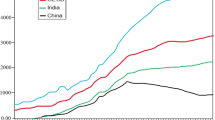Abstract
With the grouting material as focus, this study aims to guarantee that the joint with tenon and mortise constructing a metro station has the necessary waterproof performance, which shall not be poorer than the mechanical properties of the concrete with joints itself, and fine structural integrity. With groutability at low-temperature and available operational time as basis, low-temperature epoxy was selected as the grouting material for the joints. The silica powder of particular particle size and mass was added for modifying the physical performance of grouting material. A series of physical and mechanical tests were conducted in an attempt to achieve the optimal particle size and mix ratio provided that costs were reduced as practically as possible. Also, the flexural capacity of the joint filled with the above grouting material was demonstrated via the combined equal-proportion joint axial bend test.


















Similar content being viewed by others
References
Abhishek, K., Rakesh Kumar, V., Datta, S., et al. (2017). Parametric appraisal and optimization in machining of CFRP composites by using TLBO (teaching–learning based optimization algorithm). Journal of Intelligent Manufacturing, 28, 1769–1785.
Chen, C., Gu, Y., Wang, S., Zhang, Z., Li, M., & Zhang, Z. (2017). Fabrication and characterization of structural/dielectric three-phase composite: Continuous basalt fiber reinforced epoxy resin modified with graphene nanoplates. Composites Part A Applied Science and Manufacturing, 94, 199–208.
Chen, Y., Okudan, G. E., & Riley, D. R. (2010). Decision support for construction method selection in concrete buildings: Prefabrication adoption and optimization. Automation in Construction, 19, 665–675.
Dong, Y. H., Jaillon, L., Chu, P., & Poon, C. S. (2015). Comparing carbon emissions of precast and cast-in situ construction methods—A case study of high-rise private building. Construction and Building Materials, 99, 39–53.
Fu, W. (2020). Macroscopic numerical model of reinforced concrete shear walls based on material properties. Journal of Intelligent Manufacturing. https://doi.org/10.1007/s10845-020-01620-y.
Gao, X., Huang, W., Wei, Y., & Zhong, Y. (2017). Experiment and modeling for compressive strength of polyurethane grout materials. Fuhe Cailiao Xuebao/Acta Materiae Compositae Sinica, 34, 438–445.
Heng, Z., Zeng, Z., Chen, Y., Zou, H., & Liang, M. (2015). Silicone modified epoxy resins with good toughness, damping properties and high thermal residual weight. Journal of Polymer Research, 22, 203.
Hong, W.-K., Kim, G., Lim, C., & Kim, S. (2017). Development of a steel-guide connection method for composite precast concrete components. Journal of Civil Engineering and Management, 23, 59–66.
Kathalewar, M., Sabnis, A., & D’Melo, D. (2014). Polyurethane coatings prepared from CNSL based polyols: Synthesis, characterization and properties. Progress in Organic Coatings, 77, 616–626.
Li, G.-Z., & Zhang, S. (2010). Study on the property of polymer cement-based grouting material. Jianzhu Cailiao Xuebao/Journal of Building Materials, 13, 744–748.
Liu, Z., Ying, H. (2009). Prefabrication construction in residential building of Vanke real estate company China. In: International conference on management and service science, MASS 2009, September 20, 2009–September 22, 2009. Wuhan, China: IEEE Computer Society, Communication University of China, Wuhan University, James Madison University, Institute of Policy and Management, Chinese Academy of Sciences, IEEE Wuhan Section.
Mao, C., Shen, Q., Shen, L., & Tang, L. (2013). Comparative study of greenhouse gas emissions between off-site prefabrication and conventional construction methods: Two case studies of residential projects. Energy and Buildings, 66, 165–176.
Shamass, R., Zhou, X., & Alfano, G. (2014). Finite-element analysis of shear-off failure of keyed dry joints in precast concrete segmental bridges. Journal of Bridge Engineering, 20, 04014084.
Sobhani, S., Jannesari, A., & Bastani, S. (2012). Effect of molecular weight and content of PDMS on morphology and properties of silicone-modified epoxy resin. Journal of Applied Polymer Science, 123, 162–178.
Sroka, J., Rybak, A., Sekula, R., & Sitarz, M. (2016). An investigation into the influence of filler silanization conditions on mechanical and thermal parameters of epoxy resin-fly ash composites. Journal of Polymers and the Environment, 24, 298–308.
Turmo, J., Ramos, G., & Aparicio, A. C. (2006). Shear strength of dry joints of concrete panels with and without steel fibres: Application to precast segmental bridges. Engineering Structures, 28, 23–33.
Yu, J. B., Yu, Y., Wang, L. N., Yuan, Z., & Ji, X. (2016). The knowledge modeling system of ready-mixed concrete enterprise and artificial intelligence with ANN-GA for manufacturing production. Journal of Intelligent Manufacturing, 27, 905–914.
Acknowledgements
This study is supported by Opening Foundation of Shandong Key Laboratory of Civil Engineering Disaster Prevention and Mitigation (CDPM2019ZR08). This research is supported by Changchun City Orbit Traffic Ltd. of Corp Copy Right of China.
Author information
Authors and Affiliations
Corresponding author
Additional information
Publisher's Note
Springer Nature remains neutral with regard to jurisdictional claims in published maps and institutional affiliations.
Rights and permissions
About this article
Cite this article
Su, H., Li, R. & Yang, M. An experimental study of modified physical performance test of low-temperature epoxy grouting material for grouting joints with tenon and mortise. J Intell Manuf 32, 667–677 (2021). https://doi.org/10.1007/s10845-020-01664-0
Received:
Accepted:
Published:
Issue Date:
DOI: https://doi.org/10.1007/s10845-020-01664-0




